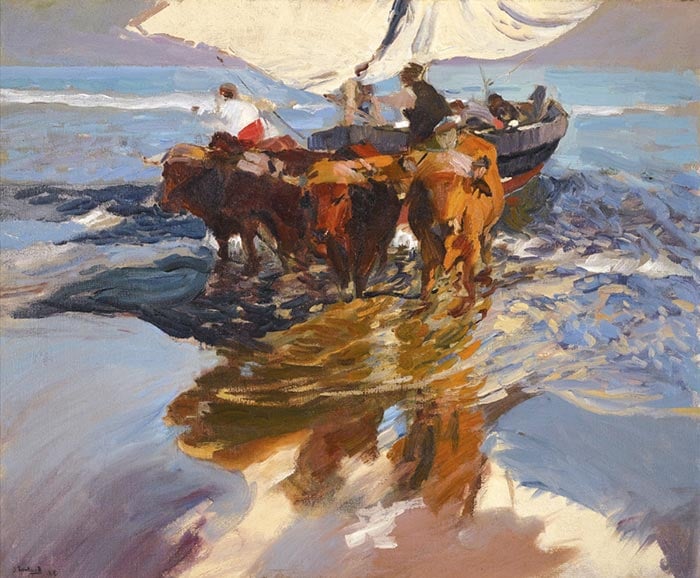
When I ask readers what they are struggling with most in painting, one of the most common replies is a struggle to paint looser and more relaxed.
This is a common problem in painting. We tend to overthink and overcomplicate things. The end result is usually a tight and overly refined painting (which is fine if that is the look you are going for).
Many artists, including myself, want our paintings to look effortless as if our paint flowed onto the canvas without hesitation. This is often referred to as a “painterly” style. Artists like Joaquín Sorolla and Richard Schmid first come to mind when I think of a painterly style.
In this post, I will go over some tips for painting looser and more relaxed.
- 1. Squint at Your Subject to See the Important Information
- 2. Think, Then Move with Confidence
- 3. Load That Brush!
- 4. Make Use of Large Brushes and Palette Knives
- 5. Start Fast, Finish Slow
- Want to Learn More?
- Thanks for Reading!
1. Squint at Your Subject to See the Important Information
An important part of painting looser is knowing what to focus on and what to simplify. If you try to paint every detail, you will struggle to paint loose and relaxed. This is where squinting comes into play.
If you ever watch a professional artist paint, you should see them constantly step back and squint at the subject. This is not because they have bad eyesight, but rather because they are using squinting to simplify their perception of values and other details.
When you observe your subject without squinting, you see all the colors, edges, lines, shapes and other details. Nature is not so convenient to arrange all the elements in a neat composition for you.
Squinting allows you to simplify all this information. When you squint, you are looking through the dark filter of your eyelashes. This makes everything appear darker and less detailed.
Instead of seeing every minor change in value, you only see large value masses. This makes it easier to differentiate the important information from the “noise”.
I will use the photo below to demonstrate what you should see when you squint. Below is what you would see when looking normally – all the colors and details in full force.

Below is more or less what you would see whilst squinting, depending on how hard you squint. This reveals a few important points:
- The lightest lights are the highlights in the clouds.
- The darkest darks are around the trees on the side.
- The mountain is all of similar value, with a few dark spots of blue.
- The blue sky is a touch lighter than the mountain.
- The light area in the grass is around the same value as the bottom of the blue sky.
All the above information is not as obvious without squinting.
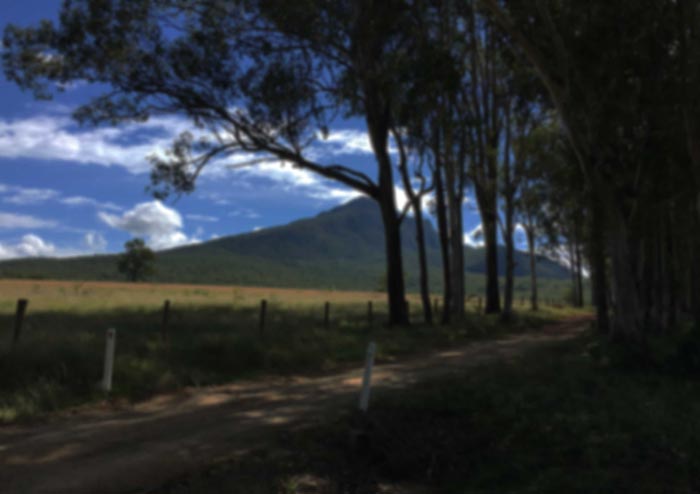
Once you know what important information you want to capture in your painting, then you can go ahead and focus on capturing that information whilst ignoring the rest. This will allow you to paint with a much looser style than if you were trying to paint every little detail.
Tip: You see less color whilst squinting, so don’t use it to see color. Only use it to see value.
2. Think, Then Move with Confidence
When most people try to paint in a loose style, they just end up with a hurried mess on the canvas. It is not about painting recklessly, but rather with confidence. To add to this, there is no point in painting with confidence if you are painting the wrong things.
So instead of rushing through your painting and hoping for the best, take more time and think about your next stroke. When you are confident in what you want to do, then commit to that stroke and don’t hold back.
Also, just because a painting looks effortless and painterly, does not mean it was painted fast. People tend to think Claude Monet only ever painted in a creative flurry on location, but he often labored over his paintings in the studio across numerous sessions.

3. Load That Brush!
I still need to remind myself from time to time to make sure I load my brush with enough paint between strokes. This is important as it allows me to paint with confident and efficient strokes.
If you do not have enough paint on your brush, then your strokes will be weak and timid. You will constantly be going back to the palette for more paint, rather than painting freely.
This also means that you should ensure you have enough paint on your palette. Otherwise, you will struggle to load your brush.
As John Singer Sargent once said:
“No small dabs of color – you want plenty of paint to paint with.”
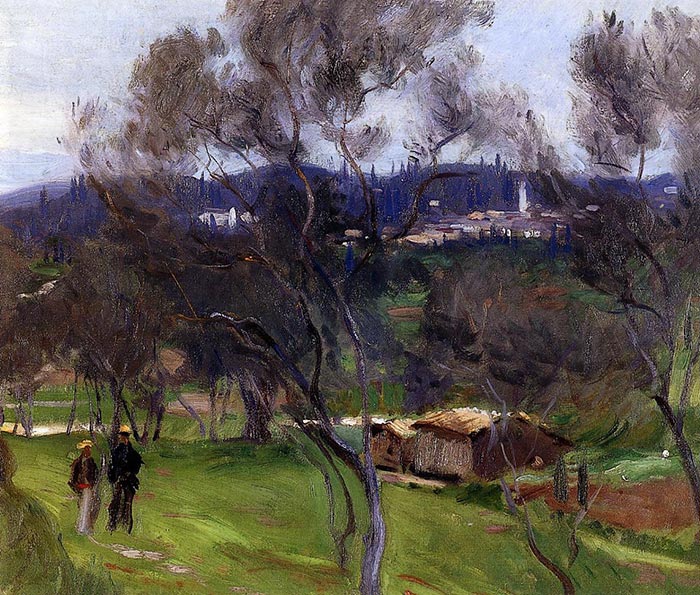
4. Make Use of Large Brushes and Palette Knives
Sometimes, when I want to loosen an area up in my painting, I will run a large brush or palette knife over the area. This helps simplify all the unwanted detail, which can build up in the painting over time.
The palette knife can also produce very interesting effects when you run it over wet brushwork. With one stroke of the palette knife, you pick up, scrape away and drag paint all at the same time. The result is usually a very loose and organic appearance. I use this technique all the time when painting the textured grounds of a landscape, or the choppy water of a seascape.
In my painting below, if you look closely you can see that the blue sky was painted with just a few long strokes of a large flat brush. The same goes for most of the water. I also used a palette knife to loosen up the trees and to add some highlights for the cliffs and buildings.

5. Start Fast, Finish Slow
If you want to paint in a looser style, then do not start slow and tight! It is much easier to start fast and loose, then tighten things up later if needed.
With most of my paintings, the start usually involves trying to capture my initial impression of the subject – the most basic formation of shapes and colors which I see. The end result of this is a no-frills painting. I can then go over and add the finer details if necessary.
Below is a progress shot of one of my paintings at the no-frills stage. Notice how all the general shapes and colors are in place, but not much else. Getting to this stage of the painting did not take long – perhaps 20 minutes.
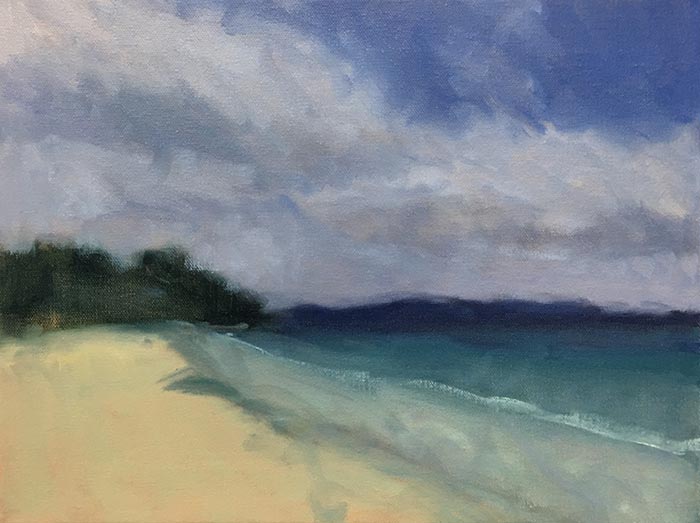
I was then able to spend a bit more time on the finer details to bring the painting home. You can see other progress shots of this painting in this post.
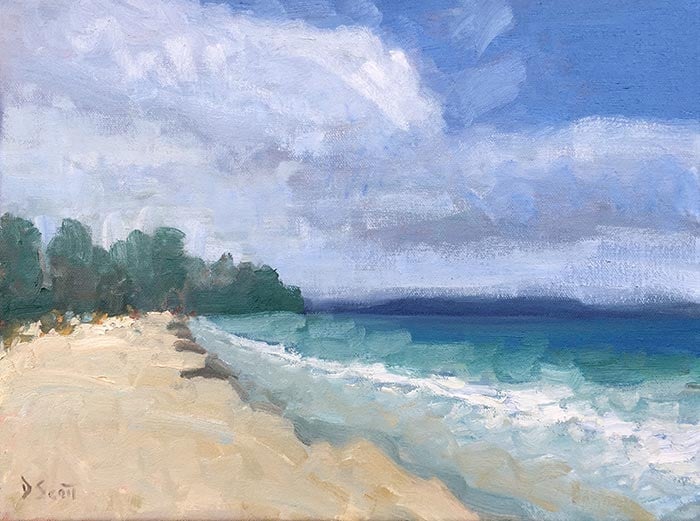
Want to Learn More?
You might be interested in my Painting Academy course. I’ll walk you through the time-tested fundamentals of painting. It’s perfect for absolute beginner to intermediate painters.
Thanks for Reading!
I appreciate you taking the time to read this post and I hope you found it helpful. Feel free to share it with friends.
Happy painting!
Dan Scott

Draw Paint Academy

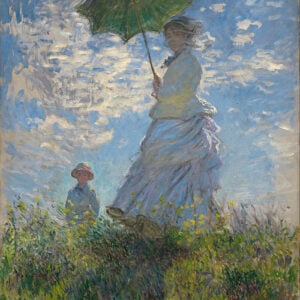


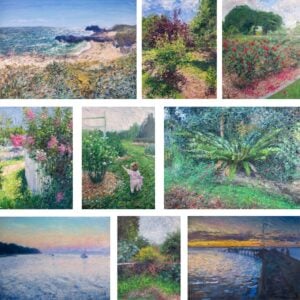
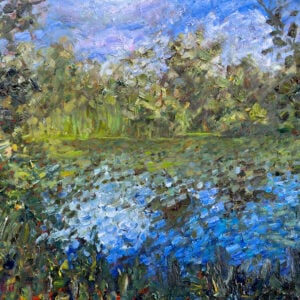
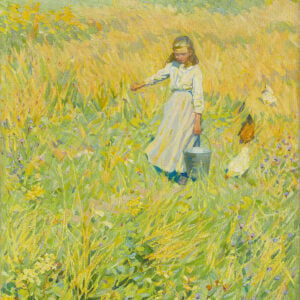
HI Dan,
I look forward to your posts and enjoy the enthusiastic manner in which demonstrate your techniques.
Thanks
Trevor Donald
South Africa
Thanks Trevor!
There seems to be a lot of talent out there in Australasia. I suppose those clear blue skies , sea and sand, coupled with lush coastal vegetation is must for artists
Thank you Dan for your continued effort to reach out to amateur artists. You talk a lot of practical sense.
Your posts are so helpful. You explain things so thoroughly with pictures to support your explanations that are very basic which makes them easy to follow. Thank you.
At first my work is a “mess” then it’s all about cleaning it up!!
Thank you for your emails…they are generously helpful.
My pleasure thanks Nancy. Same with my paintings. Always just a scattered mess at the start. Dan
My paintings change all of the time. I paint with acrylics for that reason.
I love to,paint big canvases, then I can use big brushes and knives.
Thank you for today’s lesson.
Sounds good Lynne! Dan
Thank you for the tips, I look forward to your posts. Your advice really helps me as I learn to paint. I always look forward to seeing him your next ideas.
Jack
Thanks Jack!
Thanks, Dan! Your emails always are so helpful and are very timely. They arrive when I need to address my present painting challenges!
Really glad to hear thanks Liz! Dan
Thank you Dan , I love the way you write. You speak to me like your sitting right beside me. Love the information too!!!!
Thanks Myrna!
I would love to paint like thaT.struggling to find the time though
I enjoy reading your posts. I am a beginner painter and love everything about my new hobby and especially your valuable information.
Thanks Linda! It is a great hobby.
What is your take on “negative” watercolor painting and the best way to achieve it?
Hi Nancy. To be honest, I don’t do all that much watercolor painting so I am probably not the best person to ask. I assume there might be some tutorials on Youtube? Dan
I just love getting your blog, I learn something EVERY time I read. Thank you, thank you for your passion.
Sandi,
Virginia, USA
Great! Thanks Sandi, Dan
Dan, I feel so blessed to have ever find you! You’re so encouraging that I’m painting almost every day. It’s the first time I feel so commited and I enjoy it!! Thank you so much.
So glad to read that Ana! Keep it up 🙂 Dan
Always excellent posts and information provided Dan. Thank you!
Thanks Robert! Dan
Hi Dan, your post on painting looser is definitely a keeper. With so many pointers that are sometimes forgotten, and new tips, be sure I’ll be returning to it frequently.
Thanks Susan!
Thanks so much. I get inspired by your posts and it encourages me to keep keeping on.
Is it possible for me to share my few paintings with you?
Hi Henry, of course, but I can’t guarantee I will have time to comment on them (the number of emails I get each day is building up). Cheers, Dan
Great informations, thank You!
Thank you! Dan
Your site said that if I subscribed I would get your book for free. When I clicked on the link it Sent me to a site where I could purchase the book. I still am going to give you the benefit of the doubt that it is an error and stay subscribed but if it’s not an error, not cool Dan. I hope you have a lot to teach me I really enjoyed this article because this is my #1 problem.
I feel like a ball trying to paint a line. Is that too weird?
Hi Dani. I have a free ebook which I give away to new subscribers and another one which goes into more depth. Let me know if you did not get the free one and I will send it through again 🙂 Glad you enjoyed the post. Dan
Quite useful,practical guidance.Thanks a lot
No problem! Thanks, Dan
Thank you Dan, that’s just what I needed!
Kind regards
Sybille
Great to hear Sybille! Thanks, Dan
Thanks Dan, will give it a try I like the looseness of your style and I’m nowhere near it BUT the point about having enough paint is definitly going to be worked on. Ps. Also would love to receive the free E-Book as I am a new subscriber.
Thanks,
Naina
Thanks Naina! I will email you separately. Dan
I’m enjoying your painting examples as I’m in Tasmania now. This was an excellent article!
Thanks Helen! Enjoy Tasmania. Thanks, Dan
Have not long been receiving your emails Dan, such great information. Thank you so much. Helen Brown
Great to hear Helen! Thanks, Dan
Thank you for this one! It was very helpful since I enjoy painting in acrylics. It is often difficult for me to get a softer look. I will probably read this several times. Cant wait to get to it.
No problem at all. Thanks Kathleen, Dan
I recently found your post on painting loosely and found it very helpful. Also, I was delighted to see your reference to Sorolla and his work. My grandfather, Jesus Vidal, served as Sorolla’s “agent” here in the US back in the day.
Sorolla painted a portrait of my grandfoather and it is a priceless family treasure.
Dan, Thank you! I realize that sometimes I have been doing more of the things you recommend, and those are the paintings I’m most pleased with! But I’m still inconsistent. I will work harder…at not working so hard!! (In the wrong places, that is!). I think remembering these suggestions will help me a lot!
Thank you!!
Thanks Dan!I always give myself time to read your post. It’s really helpful .
Susan Zeng
United States
Love your style Dan! I’m trying hard to loosen up – will hopefully get there 🙂
I have returned to painting after many years.
I really enjoy your posts and have found them very helpful!
Really like your tips. I am wondering if you could give a short teaching on “value”
I would appreciate. Debra
Thank you Dan, you’ve got a great talent for simplyfing and explaining how to paint.
This ‘how to paint loosely is very helpful.
Thanks, I need to loosen up, really liked the way you explained it! I am going to try to follow your advice, thanks again!
After wading through heaps of so-called instructional posts I usually feel I’m back on square one! On the contrary your tips are so focused and so beautifully illustrated that even an ancient child like me can enjoy and benefit from them. Thanks, Dan.
Dan, if you are painting a subject with a large garment, for example, is there a preferred
undertone for the garment other than your normal undertone?
Such very good advice…always…all these tactics we think we know but do not do !!!
Thank you ….
Goodday, what is the cost for the course please. As a pensioner I need to know if I can afford it before I can subscribe.
Yhank you
Loda
Hi Loda. I will send you an email direct. Chontele